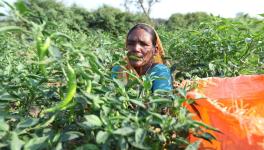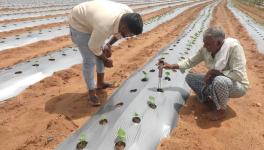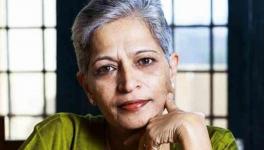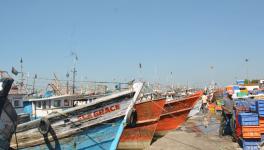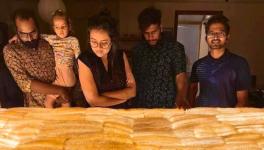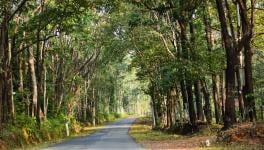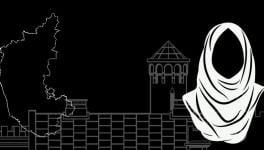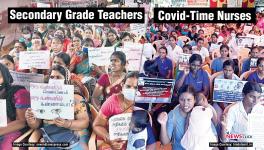The Cursed Practice of "Made Made Snana"
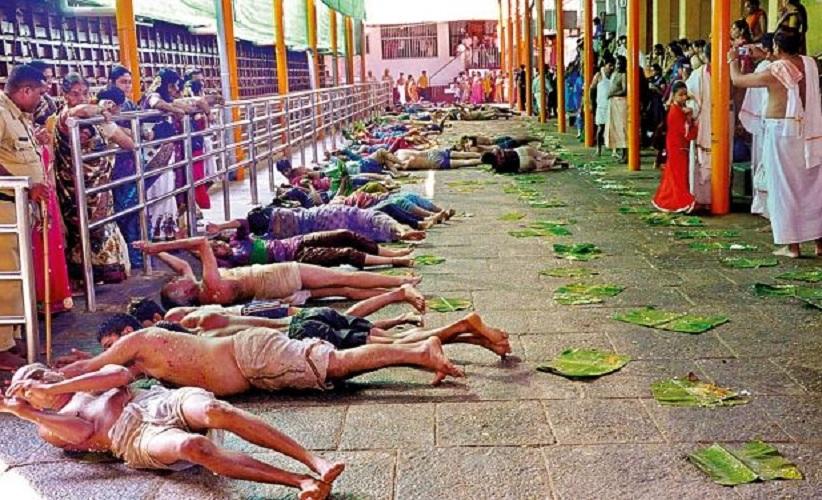
Image Courtesy: Feedurn.com
The protest by activists, intellectuals and writers against the practice of “Made Made Snana” at Kukke Subramanya and Udupi Shri Krishna temples in Karnataka, has been at low ebb for some time, thanks to the High Court’s verdict, and the Supreme Court’s stayon the verdict. “Made Made Snana”, commonly known as “Made Snana”, is the practice of devotees rolling over banana leaves on which food had been served earlier to the brahmins in a segregated part of the temple. This takes place during the Shashti festival celebrated at the Subramanya temple. While the educated imagination may get images of illiterate tribals and dalits participating in this demeaning ritual with little to cover them, the visuals made available by the media are shocking in an unexpected way. The devotees rolling on the left-overs are from the shudra and backward communities, with a small, always unconfirmed, number of brahmins. Some are middle and upper middle class, while many are educated. They have been made to believe that the practice cures skin diseases, and also purifies them of the sins they may have committed. For other devotees, it is the fulfilment of a vow taken in times of trouble. While rolling on the ground (usually around a temple), known as “Urulu Seve” in Kannada, is common in many religious places, Made Snana (“Made” is left-over in Tulu language commonly spoken in South Canara) is practised only in a few temples. It is claimed that the practice is ancient, or that it is at least five hundred years old.
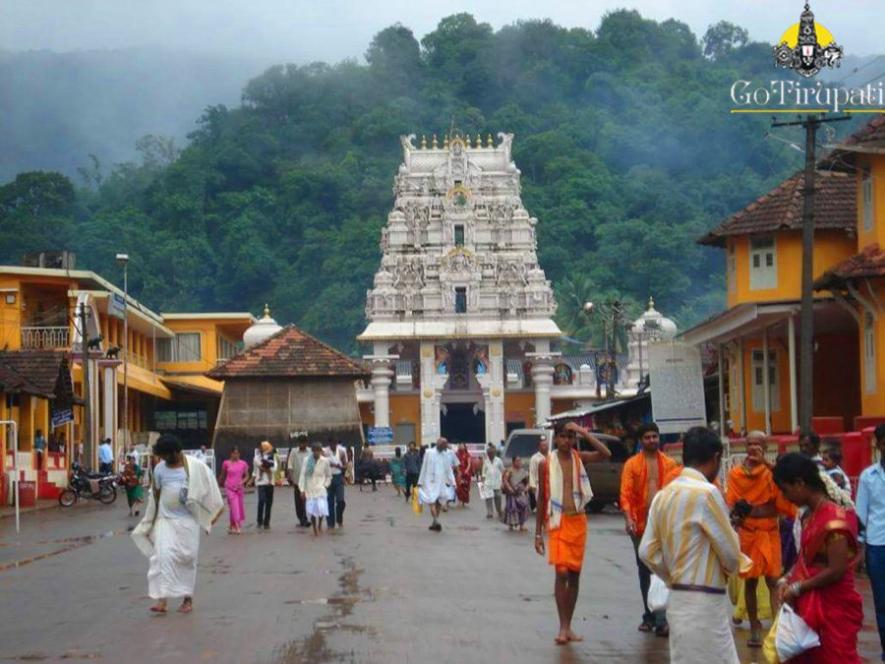
Kukke Subramanya Temple/ Image Courtesy: Gotirupati.com
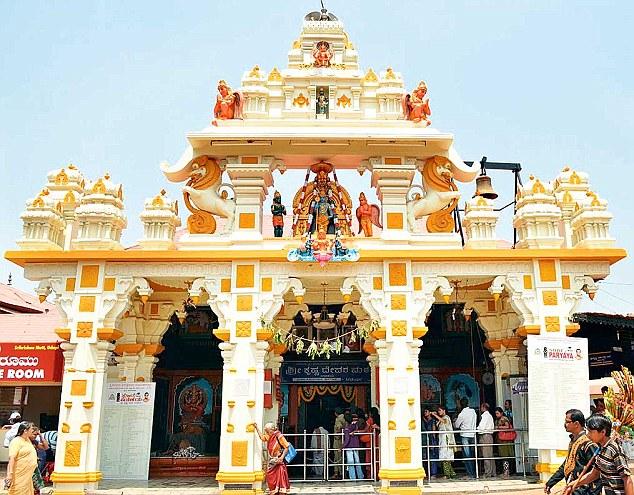
Udupi Shri Krishna Temple/ Image Courtesy: dailymail.co.uk
The brahminical priest-class supported by the temple management does everything to keep the superstitious practice going, because the Kukke Subramanya temple has an annual income of about eight crores.
Though there have been sporadic movements against such superstitious practices in Karnataka, a concerted struggle began in 2012. The CPM, led by Shri G.V. Sriram Reddy, Shri K.S. Shivaramu of the Karnataka Backward Class Awareness Forum, Mysore, and members of the Komu Souharda Vedike (Communal Harmony Forum) spearheaded the movement. They were also supported by the progressive pontiff Shri Veerabhadra Chennamalla Swamiji of Nidumamidi Matha.
Many religious heads, leading intellectuals like G. Rajashekhar, well-known rationalist Narendra Nayak and Munir Katipalya of SDPI, were the other prominent leaders. Meetings and consultations were held at Bengaluru and other places before the long jathas and protest meets were planned.
Nidumamidi Swamiji had categorically said that the practice was superstitious and disgusting. It was done in ignorance, fed by the conservative forces, and encouraged by the greedy management of the temples. The majority of devotees at the festival, and the Made Snana, are shudras and dalits. The brahminical priest-class supported by the temple management does everything to keep the superstitious practice going, because the Kukke Subramanya temple has an annual income of about eight crores. Sociologists have seen this as an example of a caste society exercising its hegemony by using brahmin superiority as its ideology. Like all regional societies in India, the society in Dakshina Kannada has a pyramidal structure with brahmins at the apex. In this case, it is the Shri Krishna Matha at Udupi, headed by the highly controversial pontiff Shri Pejawara swamiji, which has successfully carried out its “war of position” for centuries, to keep brahminical superiority unaffected. Below the brahmin community are the Nadavas or Bantas, a powerful land-owning shudra community. Below them are the Konkani communities, traditionally business and trade communities. At the broad base are the Billavas and the Mogaveeras. The Koraga community is the formerly untouchable community. The Male Kudiyas are the tribals who are playing a bafflingly unexpected role now in the entire episode of Made Snana. As writer and activist Vasudeva Uchil explains, the right-wing ideology, initially supported by the brahmins, Nadavas and the Konkani people, is now passionately embraced by the “lower castes and communities”. In Karnataka, activist parlance members of these communities are the “foot soldiers” of the right-wing. Dakshina Kannada, the western coastal belt of Karnataka, was the first to be transformed by colonial modernity. The Christian missionaries established strong school and healthcare systems, the first vernacular press, brought out the first newspaper in Kannada, and laid down the foundations of modern Kannada scholarship.
The RSS and its parivar have made Dakshina Kannada a violent, turbulent region, where the right-wing ideology has infiltrated into the civil society.
Social reform movements and the freedom struggle were vibrant here. Long before Gandhi’s pro-Harijan movement made its impact, Kudmul Ranga Rao had started educational institutions for dalits, and also led a reform-campaign for them. In the Karnataka social imaginary, Mangalore has always stood for modernity, enterprise and a liberal way of life. But in the last three decades, in the post-Babri Masjid period, there has been intensive communalisation of the region. The RSS and its parivar have made Dakshina Kannada a violent, turbulent region, where the right-wing ideology has infiltrated into civil society. Not surprisingly, in the last decade, some radical Muslim fundamentalist organisations have entered the fray, reinforcing the communal divide. The pub attack on women in Mangalore led by the Sriram Sene, the spate of killings at Sulya and Bantwal, and the attacks by cow-vigilante groups in recent years, have made Dakshina Kannada a platform for communal politics. The Communal Harmony Forum, the CPM, the Farmers’ Organisations and activists have been fighting to keep the society from reaching a point of no return.
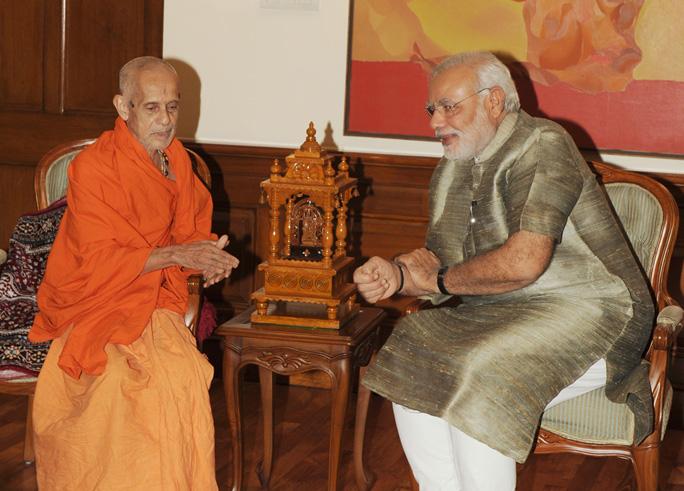
The Pejawar Swamiji of the Udupi Matha is a staunch supporter of the RSS, and has always held a high position in the Vishwa Hindu Parishad. He was present at the demolition of the Babri Masjid, though he has claimed that he did not support the demolition.
It is this background which helps one to understand the cultural politics behind the resistance to the struggle for banning the cursed practice of Made Snana. The Pejawar Swamiji of the Udupi Matha is a staunch supporter of the RSS, and has always held a high position in the Vishwa Hindu Parishad. He was present at the demolition of the Babri Masjid, though he has claimed that he did not support the demolition. He has also consistently projected himself as a liberal, reform-minded pontiff, with well-publicised visits to dalit colonies, and last month’s “Ifthihar” dinner to Muslims in the Udupi Matha. He has announced that a VHP meet, or a Dharma Sansad, will soon be held at the Udupi Matha, and the date of construction of the Rama Mandir at Ayodhya declared. An example of the clout of the Pejawar Swami is that he was among those Hindus who signed a petition submitted to counter the dalit group’s claim that there is discrimination against dalits in England. The petition was submitted to the British Government and Parliament to put pressure on the parliamentary committee to exclude caste-based discrimination, and retain only racial discrimination in its recommendations.
Activists have called for an end to this discriminatory practice based on brahmin purity and superiority. At the Matha, brahmins are served food separately.
The protest against Made Snana was triggered off by two incidents relating to the humiliating practice of segregating brahmins and non-brahmins at the communal dinners served at the Udupi Shri Krishna Matha and the Paraja Matha. Activists have called for an end to this discriminatory practice based on brahmin purity and superiority. At the Matha, brahmins are served food separately. In two separate incidents, two educated and well-connected women belonging to the Nadava (Banta) and Gouda Saraswath communities, who were sitting down for dinner with brahmin friends, were unceremoniously and humiliatingly asked to get up and leave. Both of them later protested, their caste organisations made some noises, everything was somehow patched up. Various progressive organisations came together to demand an end to both the Pankthi Bhedha practice of segregating brahmin and non-brahmin communities at the dinner in the Mathas, and the horrendous practice of Made Snana. The Pejawara Swamiji and the temple authorities merely talked about old beliefs, ancient practices, and above all, denial of any force on their part. K.A. Shriramu, and the CPM led a long jatha leading to a protest at the Udupi Matha itself. To foil the protest, the BJP-led government allowed the police to lathi-charge the activists, and jailed hundreds of activists and slapped cases against CPM leaders and activists. On the other hand, devotees freely vented their anger at the intellectuals and activists for trying to tamper with their personal beliefs and religious practices. Their major argument was that they were participating in the Made Snana voluntarily, and that they had the right to religious faith and belief. The highly partisan and communalised Kannada media played its unethical role of denigrating the progressive organisations and painting the protest as anti-Hindu. However, the public debates clearly pointed out the future of the rationalist struggle against superstitious practices.
The discourse relies heavily on the sanctity of the constitutional right of freedom of faith and worship. What has been added to the discourse is the highly effective notion of “hurting religious feelings”.
The most formidable challenge would come from a discourse carefully constructed by the Sangh Parivar, conservative religious institutions, and the right of centre “intellectuals”. The discourse relies heavily on the sanctity of the constitutional right of freedom of faith and worship. What has been added to the discourse is the highly effective notion of “hurting religious feelings”. The discourse is being used to rally forces against any effort, by any government, to enact legislations relating to religious practices. In reality, this has been translated as the right of any group, any political outfit, or any association, to push back any attempt to reform inhuman and humiliating practices. Most importantly, the purpose is not to allow any “secular” move to monitor, or control the power of the religious institutions. For example, the Bill on prevention of (regulation) superstitious practices was practically defeated before it was even introduced in the Karnataka legislative assembly. Elected members of the BJP swore to sacrifice their lives, rather than allow any discussion of the Bill. The Kannada media ran a 24×7-propaganda on the evil designs to destroy Hinduism. The Congress government’s cabinet was relieved that the opposition had stalled the Bill!
All of this happened along with the struggle to ban Made Made Snana. The Pejawar Swamiji came out with a compromise solution of replacing Made Snana with “Yede Snana”. Yede refers to the prasada, food offering to gods. He suggested that the prasada, or yede, would be made available for the devotees to roll over.
In the midst of all this, a shocker came from the association of the tribal Male Kudiya community. The community is traditionally given the task of decorating the festival chariot along with other tasks. The president of the Male Kudiya Association literally denounced the activists and protestors for trying to destroy the traditional belief-system of the tribal community. In an effectively worded statement which was later placed before the Karnataka High Court it was said:
“…It is a sort of cathartic communication with the supreme divine for many. The ritual should never be gauged in terms of logic because it is a subjective matter governed by sentiments and belief system of the people performing it”
This statement contains the other dangerous discourse against any attempt to reform traditional practices. Here was a community whose members were to be protected from demeaning practices controlled by brahminical hegemony, saying that the ancient practices involving the community were too sacred to be tampered with. It even talked eloquently about the intensity of the religious experience involving the loss of the self in the practice of Made Snana. The arguments and the discourse have a curious resemblance to the ones used in U.R. Ananthamurthy’s response to the only successful attempt by the government of Karnataka to ban a humiliating practice. Prof. B. Krishnappa, founder of the Dalita Sangharsha Samiti, led a struggle against the nude worship at the Renuka temple near Chandragutti in Shimoga district. There was rioting and violence by the devotees; and activists were beaten up and chased away. But the government went on to ban the nude worship which is held even today – nearly three decades after being banned.
U.R. Ananthamurthy, who had no knowledge of the movement, wrote “Why not worship in the Nude”blaming anglicised, “modern” middle class intellectuals who did not know the metaphysical, mystical implications of nude worship. Curiously, the petition of the Male Kudiyas uses exactly the same discourse. I am sure that if there is a national intellectual debate on Made Snana, there will be a deluge (DeLuz included) on the limits of reason, instrumental rationality, the evil called enlightenment, and the subjugation of indigenous knowledge systems. Activists against Made Snana are talking about the only form of reason and rationality they know of. This is the rationality which the Kannada Vachanakaras of the twelfth century and the poet saints of the Bhakti tradition used to denounce caste-based inequalities, inhuman superstitious practices and the unethical power of the priest-class.
To return to the narrative, with such arguments and counter-arguments, it was inevitable that the matter should be taken to the court. The “Made Snana” issue was heard by the High Court, and it recommended the modified “Yede Snana” instead of the traditional Made Snana. What is disturbing is that the constitutional freedom accorded to religious faith was once again interpreted to mean denial of power to the secular state, to eradicate humiliating superstitious practices. The Supreme Court has imposed a stay on the High Court’s verdict. Newspapers report that the central government has submitted an affidavit to the Supreme Court expressing its opinion that such practices in Karnataka and Maharashtra are unacceptable; and this may revive the struggles against “Made Snana” and such superstitious practices. Meanwhile, with less than a year to go before the polls, the government of Karnataka has not tabled the Bill on prevention (Regulation) of superstitious practices. As a wit commented, it is perhaps waiting to select an auspicious moment by consulting astrologers and a proper Vaastu for the legislative assembly by consulting a Vaastu expert!
Disclaimer: The views expressed here are the author's personal views, and do not necessarily represent the views of Newsclick.
Get the latest reports & analysis with people's perspective on Protests, movements & deep analytical videos, discussions of the current affairs in your Telegram app. Subscribe to NewsClick's Telegram channel & get Real-Time updates on stories, as they get published on our website.









